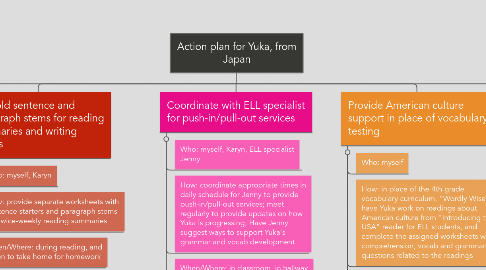Action plan for Yuka, from Japan
by Katie Lootens

1. Coordinate with ELL specialist for push-in/pull-out services
1.1. Who: myself, Karyn, ELL specialist Jenny
1.2. How: coordinate appropriate times in daily schedule for Jenny to provide push-in/pull-out services; meet regularly to provide updates on how Yuka is progressing; Have Jenny suggest ways to support Yuka's grammar and vocab development
1.3. When/Where: in classroom, in hallway nook, or in ELL resource room
1.4. Why: Yuka is developing English vocabulary rapidly, but needs support for a more systematic way of acquiring grammar and syntax
2. Pre-teach math vocab
2.1. Who: myself, Karyn (lead classroom teacher), and ELL specialist
2.2. How: pre-teach math vocabulary before lessons with visual aids, trying not to rely too much on direct translation; look ahead to word problems to signal which operation to use
2.3. When/Where: consistently; once a week meet to look ahead at next lessons to scaffold vocab and problems; ELL specialist will go over during push-in 2x/week during math
2.4. Why: Yuka is a strong math student and being confident in this subject may help her to feel more confident in other areas
3. Allow Yuka to share culture and facts about Japan in morning meetings
3.1. Who: myself, Karyn, other classmates
3.2. How: Ask Yuka if she would like to prepare to share facts about Japan in our morning meeting; I will model with another country. Have other students ask questions that Yuka can respond to the next day (giving her time to think and to see the questions written down)
3.3. When/Where: at morning meeting for one week
3.4. Why: This will give Yuka a chance to feel like an expert, and will also give her time to respond to questions without having to do so immediately and orally. It will also interest other students in her and may spark conversations among students.
4. Scaffold sentence and paragraph stems for reading summaries and writing pieces
4.1. Who: myself, Karyn
4.2. How: provide separate worksheets with sentence starters and paragraph stems for twice-weekly reading summaries
4.3. When/Where: during reading, and given to take home for homework
4.4. Why: Paragraph form is difficult for Yuka, who is used to writing vertically. She also needs sentence scaffolds for how to talk about her reading, particularly when she is reading in Japanese (as we allow for her 30 minutes of nightly reading)
5. Provide American culture support in place of vocabulary testing
5.1. Who: myself
5.2. How: in place of the 4th grade vocabulary curriculum, "Wordly Wise," have Yuka work on readings about American culture from "Introducing the USA" reader for ELL students, and complete the assigned worksheets with comprehension, vocab and grammar questions related to the readings
5.3. When/Where: Twice weekly when other students are working on Wordly Wise activities/quizzes; in hallway nook
5.4. Why: the Wordly Wise vocab program is extremely advanced for a new ELL and was taking Yuka so much time each week that it was not worth the effort; additionally, she needs support in learning abut American culture and history, and the readings are written specifically for newcomers to the US who are new to English.


